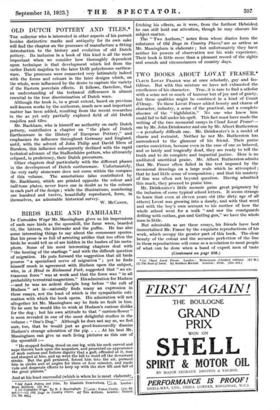OLD DUTCH POTTERY AND TILES.*
THE collector who is interested in other aspects of his pursuit besides distinctive marks and antiquity for its own sake will find the chapter on the processes of manufacture a lilting introduction to the history and evolution of old Dutch pottery. Its inclusion in a book of this kind is all the more important when we consider how thoroughly dependent upon technique is that development which led from the earlier Dutch majolica to the later Delft polychrome earthen- ware. The processes were connected very intimately indeed with the forms and colours in the later designs which, on the whole, were influenced by the desire to capture the variety of the Eastern porcelain effects. It follows, therefore, that an understanding of the technical differences is almost essential to the true discrimination of Dutch ware.
Although the book is, to a great extent, based on previous well-known works by the authoress, much new and important matter has been added, resulting from the recent researches in the 83 yet only partially explored field of old Dutch majolica and tiles.
Mr. Rack-ham, who is himself an authority on early Dutch pottery, contributes a chapter on "the place of Dutch Earthenware in the History of European Pottery," and emphasizes its influence throughout Germany and England, until, with the advent of John Philip and David Elers of Burslem, this influence subsequently declined with the rapid technical advance of the Staffordshire potters, who ultimately eclipsed, in proficiency, their Dutch precursors.
Other chapters deal particularly with the different phases in the development of Dutch earthenware. Unfortunately, the very early stoneware does not come within the compass A this volume. The annotations (also contributed by Mr. Rackharn), which are printed opposite the colour and half-tone plates, never leave one in doubt as to the colours In each part of the design ; while the illustrations, numbering one hundred and twelve, beautifully reproduced, form, in themselves, an admirable historical survey.
W. McaxcE.


































 Previous page
Previous page